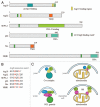Mitochondria removal by autophagy
- PMID: 21252623
- PMCID: PMC3359476
- DOI: 10.4161/auto.7.3.14502
Mitochondria removal by autophagy
Abstract
Mitochondrial dysfunction has severe cellular consequences and is linked with neurodegenerative diseases and aging. Maintaining a healthy population of mitochondria is thus essential for proper cellular homeostasis. Several strategies have evolved to prevent and limit mitochondria damage, and macroautophagy plays a role in degrading superfluous or severely damaged mitochondria. Selective removal of mitochondria by autophagy (termed mitophagy) has been extensively studied recently in both yeast and mammalian cells. In this review, we summarize our current knowledge of mitophagy. We also compare the molecular process of mitophagy with other types of specific autophagic pathways and discuss its biological importance.
Figures

References
Publication types
MeSH terms
Substances
Grants and funding
LinkOut - more resources
Full Text Sources
Other Literature Sources
Molecular Biology Databases
